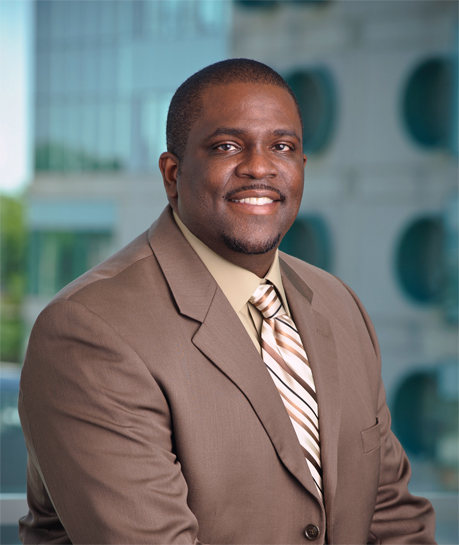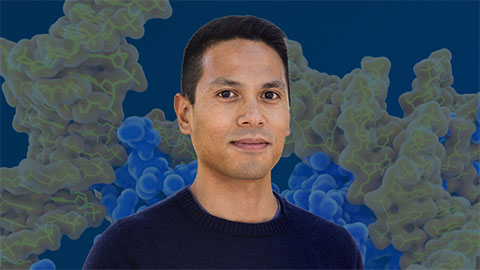Meet Russell DeBose–Boyd
For Russell DeBose–Boyd, a professor of molecular genetics at the University of Texas Southwestern Medical Center at Dallas, the lab and the kitchen are both carefully controlled canvases. A native of Boswell, Oklahoma, a town with a population of 700, Debose–Boyd attended Southeastern Oklahoma State University as an undergraduate and received his Ph.D. from the University of Oklahoma Health Sciences Center in Oklahoma City before taking a position at UT Southwestern. He joined the ranks of associate editors at the Journal of Lipid Research in January. DeBose–Boyd spoke with John Arnst, ASBMB Today’s science writer, about his lab’s work and his longtime interest in cholesterol synthesis. The interview has been edited for clarity and length
 Russell DeBose-Boyd, whose lab currently includes an assistant professor, two postdoctoral fellows, three graduate students and two lab technicians.
Russell DeBose-Boyd, whose lab currently includes an assistant professor, two postdoctoral fellows, three graduate students and two lab technicians.
What is your group focused on?
For almost my entire career, I’ve studied the feedback regulation of an enzyme called HMG-CoA reductase. It’s the rate-limiting enzyme in the synthesis of cholesterol as well as a number of what we call nonsterol isoprenoids that play a variety of roles in cells.
It turns out that because the reductase is the rate-limiting enzyme in the pathway, it’s subject to an enormous amount of feedback regulation at the level of transcription, translation and protein degradation.
Importantly, each one of these regulatory mechanisms is controlled by sterol and nonsterol isoprenoids that are produced in the cholesterol biosynthetic pathway.
My ultimate goal, when I started my lab, was to understand, in molecular detail, every single mechanism for feedback regulation of HMG-CoA reductase. The transcriptional regulation of HMG CoA reductase has been elucidated through the work of my postdoctoral advisers, Michael Brown and Joseph Goldstein (author’s note: Brown and Goldstein were awarded the Nobel Prize in physiology or medicine in 1985 for their discoveries concerning the regulation of cholesterol metabolism, which would lead to the development of statin drugs), in a well-recognized manner. Thus, the initial goal upon starting my own laboratory was to understand how sterol and nonsterol isoprenoids combine to regulate the degradation of HMG-CoA reductase. We largely continue to focus on that, and we’ve discovered the pathway by which it occurs. Using cultured cells and in vitro assays, we’ve discovered that certain types of sterols cause HMG-CoA reductase to become polyubiquitinated, marking the enzyme for recognition and degradation by 26S proteasomes. The laboratory now is focused on determining mechanisms by which a specific nonsterol isoprenoid, called geranylgeranyl pyrophosphate, augments degradation of ubiquitinated HMG-CoA reductase and how this augmentation becomes disrupted in a rare human eye disease called Schnyder corneal dystrophy. In addition, we’ve recently embarked upon an area of investigation to understand how sterol-accelerated degradation contributes to the overall regulation of the reductase and cholesterol synthesis in whole animals.
What is your background and research training?
My interest in research really stems back to my time as an undergraduate at Southeastern Oklahoma State University. I was involved in a National Institutes of Health-supported program that at the time was called the Minority Biomedical Research Support Program, or MBRS. What was really nice about the MBRS program was that, each year, our entire lab would attend a national symposium at which several well-known scientists presented their latest research. At the first meeting I attended during my freshman year in college, I was in awe over some of the cool things scientists from great universities were doing, and that really sparked my interest. I decided at that time that I wanted to pursue a career in research.
After my undergraduate career, I moved to the University of Oklahoma Health Sciences Center in Oklahoma City, where I worked with Richard Cummings on glycosylation in parasitic worms.(Author’s note: Cummings is one of the co-founders of the fields of glycomics and glycobiology.) We were looking at enzymes that generated parasitic antigens in Schistosoma mansoni (author’s note: one of the major contributors to the neglected tropical disease schistosomiasis). I also dabbled in looking at the glycosyltransferases in C. elegans as kind of a model for some of the enzymes that the parasite made. During that time, I gained an interest in cholesterol metabolism. Once I finished defending my thesis at OU, I decided to move here to Dallas to work with Brown and Goldstein, and I’ve been here ever since.
What was your involvement with the JLR prior to becoming an associate editor?
I’ve been an avid reader of articles published by the JLR since my postdoctoral years when my research began to focus on the regulation of cholesterol metabolism. My group has been fortunate enough to publish several articles in the JLR, and on many occasions I served as an ad hoc reviewer of JLR manuscripts. My formal association with the JLR began in 2013 when I was invited to serve on the editorial board, and my role was expanded in January, when I was invited to become an associate editor of the journal.
What was your reaction when you were asked to become an associate editor?
I was actually surprised, but it was an honor because I felt that it gave me another level of responsibility, and it actually is helping me as far as broadening my perspective. Two areas I really focus on are cholesterol metabolism and isoprenoid metabolism in cultured cells, but as an editor, I see a wide variety of papers that all have something to do with lipid metabolism. I think it really forces me to become more knowledgeable about areas I’m familiar with but don’t know in great detail. I think that’s the most exciting aspect of being an associate editor.
Have you been surprised by anything during your time so far as an associate editor?
I never realized the level of commitment that reviewers have, which is amazing considering that all of us have very busy schedules. The editorial board members also seem like they all take this job seriously; they really accommodate my requests in a timely manner. So far, it’s been a really smooth transition from editorial board member to associate editor.
What do you do outside of the lab? Do you have any hobbies?
I work out with my boys. I have two sons — they’re actually grown now, they’re 22 and 20 — and we hang out quite a bit riding bikes and working out. I also love to cook. It took me a while to realize why I like to cook on the weekends. My wife wonders, “Why are you cooking so much?” Well, I think it’s because over the years, as I’ve risen through the ranks, I just have no time whatsoever to work in the lab, and I miss that. I used to love to work in the lab — nothing is more satisfying than getting that result and evaluating data fresh off the press, if you will. I think cooking may help replace that. It’s not the same as doing experiments, but there are similarities. When I follow a particular recipe, I try to be very meticulous about putting dishes together, and the end result is that it’s good or bad. Like my experiments, I tend to learn more when my dishes turn out bad. This forces me to re-evaluate my efforts, correct them the next time and ultimately create a near-perfect dish.
My absolute favorite recipe is spaghetti from scratch. I love to experiment with the recipes. For example, I use canned tomatoes in my sauce, which kind of makes me feel like I’m cheating. My next goal is to gain enough confidence to fire-roast fresh tomatoes, garlic and onions to use in my sauce.
Do you have any advice for scientists in training for balancing life within the lab with life outside it?
I tell students and postdocs that the work in the lab is very important, but equally important is your life outside of the lab. As scientists in the academic setting, we’re always under pressure to produce, perform and progress. Fortunately, many of us find science fun and extremely gratifying; we’re willing to give it our all and work as hard as possible. However, it is equally important that we take time out for ourselves and spend quality time with our families and significant others. This helps to prevent that burned-out feeling and gives us time to relax our minds.
Enjoy reading ASBMB Today?
Become a member to receive the print edition four times a year and the digital edition monthly.
Learn moreGet the latest from ASBMB Today
Enter your email address, and we’ll send you a weekly email with recent articles, interviews and more.
Latest in People
People highlights or most popular articles

Nuñez receives Vallee Scholar Award
He will receive $400,000 to support his research.

Mydy named Purdue assistant professor
Her lab will focus on protein structure and function, enzyme mechanisms and plant natural product biosynthesis, working to characterize and engineer plant natural products for therapeutic and agricultural applications.

In memoriam: Michael J. Chamberlin
He discovered RNA polymerase and was an ASBMB member for nearly 60 years.

Building the blueprint to block HIV
Wesley Sundquist will present his work on the HIV capsid and revolutionary drug, Lenacapavir, at the ASBMB Annual Meeting, March 7–10, in Maryland.

In memoriam: Alan G. Goodridge
He made pioneering discoveries on lipid metabolism and was an ASBMB member since 1971.

Alrubaye wins research and teaching awards
He was honored at the NACTA 2025 conference for the Educator Award and at the U of A State and National Awards reception for the Faculty Gold Medal.

